Two weekend reports … but first the big news
I’ve fallen a tad behind in my weekend sales survey reporting, so I’ll be bringing you two weekends this time—Memorial Day and June 1-2. But before I get to that, here are the hard news stories:
ColorPoint trades flowers for hemp
A local newspaper article, forwarded to me by someone in the know, clued me in to the news that two major Midwest greenhouses are soon to be converted from bedding plants to hemp. That will remove about 5.4 million sq. ft. (124 acres) of greenhouse production—plus lots of accompanying outdoor production space—from the Midwest mass market business.
The operation in question is ColorPoint, owned by brothers Art and Ken VanWingerden, with locations in Kentucky and central Illinois (the former Mid-American Growers facility).
It’s worth noting that each location is getting a different owner/partner. ColorPoint’s original Paris, Kentucky location, which Art and Ken built in 2001, is merging with AgTech Scientific, a Kentucky firm founded in 2015 to focus on researching CBD as an additive for pet and horse food. The companies have been granted both a Hemp Grower License and Hemp Processor License from the Kentucky Department of Agriculture. Art and Ken will be active partners in the new venture.
Meanwhile, ColorPoint’s Granville, Illinois, location, which Art and Ken bought from their brother Nick in 2014, has been sold to Red, White & Bloom, an operating division of MichiCann Medical, a private cannabis investment firm based in Ontario, Canada. Red, White & Bloom plans to use the greenhouse as its U.S. anchor, establishing large-scale production capabilities focused on hemp extraction and product manufacturing. They already have experience establishing standardized cannabis production in Canada to produce hemp CBD and CBD-derived medicines and products.
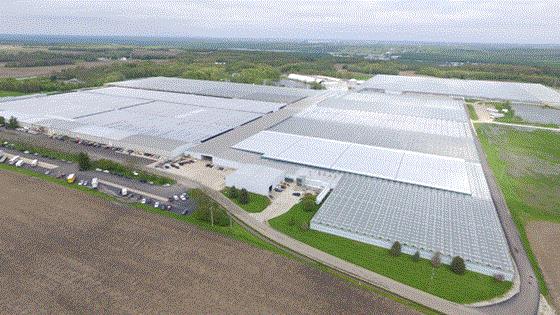 Ironically, I was recently at ColorPoint in Illinois for a photo shoot for the cover of the June GrowerTalks. That’s when I took this photo. I toured the greenhouse, but should have been looking a bit more closely, or asking more questions. Maybe I’d have sussed out the scoop!
Ironically, I was recently at ColorPoint in Illinois for a photo shoot for the cover of the June GrowerTalks. That’s when I took this photo. I toured the greenhouse, but should have been looking a bit more closely, or asking more questions. Maybe I’d have sussed out the scoop!
Both deals got their start in 2017, when AgTech was searching for greenhouse growers to help them meet their hemp needs and found ColorPoint KY. They beta-tested greenhouse-grown hemp in 2018, and formed a business relationship for the 2019 outdoor farming season. AgTech planned to partner with ColorPoint on hemp in between their flower season; however, Art and Ken, recognizing the opportunity, and knowing the ongoing challenges of the mass market bedding plant business, wanted to accelerate the relationship, which is why they have merged and are now converting the entire Paris operation to produce hemp exclusively—young plants for local farmers and greenhouse-grown finished plants for extraction.
As for the Granville, Illinois, location, it sounds as though that’s an outright sale. The VanWingerden brothers were introduced to Red, White & Bloom (RWB) through their association with AgTech. They were granted a Hemp Grower License and Hemp Processor Registration from the Illinois Department of Agriculture this spring. RWB plans to retain the Illinois management team.
In a press release, RWB CEO Brad Rogers stated, “We continue with our plan to rapidly expand from our base in Michigan and invest in scaled operations across the United States as we bring together additional components of our multi-state operator strategy.”
Sounds like they might have their eye on more greenhouse operations …
Back in Paris, about 15 minutes from the ColorPoint greenhouse, AgTech is busy building a 50,000 sq. ft. extraction and manufacturing facility, projected to open in August. They expect to be able to process 14,000 lbs. of hemp biomass daily by Q2 of 2020.
Of course, anytime I hear about a big sale or purchase like this, I want to know what’s behind it. Why did ColorPoint decide to do this deal? While I haven't gotten an answer straight from the brothers yet, I did get a corporate answer from ColorPoint spokesman Steve Sloan, VP of Business Development:
“The Big Box retail environment has become increasingly competitive and challenging over the past decade as retailers compete against each other and ever-formidable online shopping options for consumer market share. As a result, it has become increasingly difficult for floricultural suppliers to successfully provide increasingly costly products and services at margins that will support a successful and sustainable business. In response to these pressures, over the last several years we have been looking for new customers, new products and new approaches for our business with the purpose to be more sustainable and successful by more fully utilizing greenhouse space during off-peak seasons.”

Free State Growers destroyed by tornado
When I Google a greenhouse, I don’t want the top stories about it to be headlined “Linwood nursery greenhouses take direct hit from tornado” and “Free State Growers flattened by twister.” But that’s what happened the evening of Tuesday, May 28, when strong storms hit the midsection of the country.

I snagged this photo from a video by KMBC—my thanks to them.
Free State Growers is the new name for the former Alex R. Masson range, founded exactly 100 years ago in Linwood, Kansas. It was purchased by former employees Mark and Andrea Illausky in 2012, and they’ve been running the 9-acre foliage, tropicals and bedding operation as Free State Growers since then.
According to news reports, Mark arrived at the greenhouse at 7 p.m. to find it destroyed. Up till then, he had only seen tornadoes on television, he told reporters. Thankfully, despite the total destruction, no one was injured—although Licsandro Gamboa could have been. He was there that night, standing in for a watchman who was on vacation. He ran from the greenhouse and huddled next to a small tractor until the twister passed. His thoughts as he watched the devastation happen? “I need to see my son one more time.”
I reached out to Mark via email, and he graciously replied with a few more details and some brief answers to my questions. His first comment was, “I’m thankful that our employees are safe.”
Chris: What is your day-to-day plan moving forward after such a major disaster?
Mark: “Right now and for the near future we are assessing the situation from a high vantage point. The structures are absolutely decimated except for one greenhouse structure. Power and water are essential and currently we are lacking both.”
Chris: Have you stopped to consider the idea of perhaps not rebuilding? Or is there no question that you’ll reuild bigger and better?
Mark: “I didn't think for a second about not rebuilding. I feel like I have to, and yes, I would like to make it better than before. I look at this as an opportunity.”
Chris: I hear the industry is reaching out, such as Dan Parcel at Kaw Valley offering growing space [Dan is who first told me of the tornado]. Can you talk about that a bit?
Mark: “The industry has absolutely reached out to us. This is one of those times that you realize how tight-knit we all are. Many growers have reached out to offer greenhouse space, insurance consulting, product, portable greenhouses, even tractor trailers. One of our customers, Home Depot, sent district managers and store managers to help the day after.
“I want to thank everyone for their support and prayers. It will be a very long road, and after the media trucks leave we will still be here. But I believe in my employees and we will move forward.”
As one more example of the power of these storms, one news report said that a plastic pot from the nursery was found 50 miles away in Smithville, Missouri.

Nearby, a survival celebration
Pendleton’s Kaw Valley Country Market in Lawrence, Kansas, also hit by a tornado on that same Tuesday, held a survival celebration sale June 1 and 2 to clear out as much plant material as possible so they wouldn’t have to take care of it, allowing them to focus on cleanup and rebuilding. Owners John and Karen Pendleton lost five of their seven greenhouses to the storm.
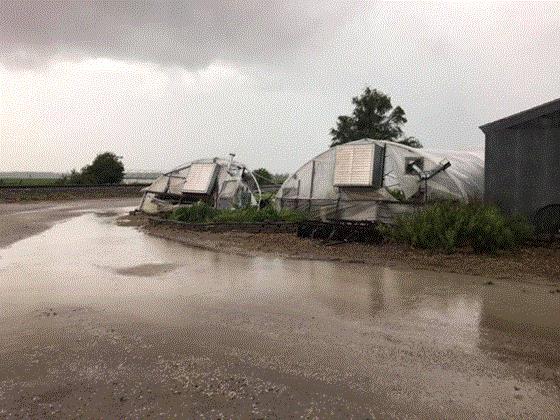
The event was a success, according to their Facebook page, maintained by their daughter Liz, with customers turned out in droves to shop and offer a helping hand.
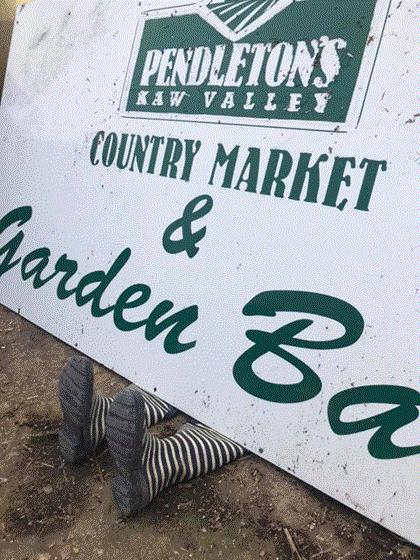
I love how the family has maintained its sense of humor through the crisis.
How was Memorial Day?
Phenomenal and even record-breaking for some of you (East, New England), and wet and blah for some others (West, Plains). The national averages? A very solid 7.7 in the U.S. and a fairly dud 6.6 in Canada (but don’t worry, there’s an explanation for that Canadian score, which really isn’t as bad as it seems).
Here’s the map:
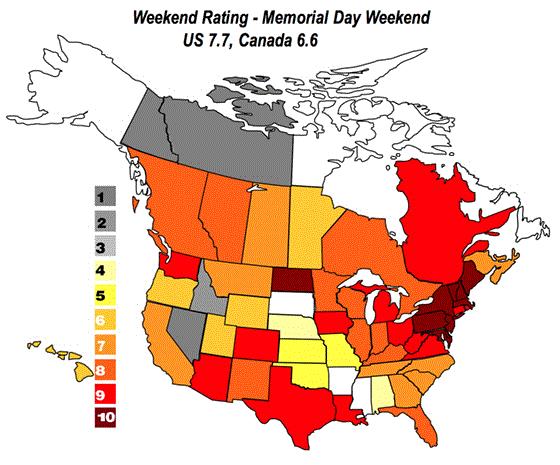
That’s based on 132 scores from 46 states and nine provinces. You sent in 30 10s total, or 23% of all scores.
For fun and edification, here are all the previous Memorial Day Weekend scores since I started this crazy exercise:
2019 7.7/6.6
2018 7.4/9.3
2017 7.9/8.7
2016 8.1/8.8
2015 7.7/8.6
2014 9.0/7.8
2013 7.4/7.4
2012 6.8/8.3
2011 6.9/6.1
The aforementioned hot spot region East scored 9.7 and New England was close behind at 9.5. Scores were almost universally 10s and 9s, with just one seven among the dozen states represented. New Hampshire was all set for a perfect 10 until the fifth respondent had to get all gloomy with a 9. New Jersey did score a perfect 10, but from only two scores. Connecticut had 10, 10, 10, 9 and 8, for a 9.5 average.
Next came the Midwest spot-on the national average at 7.8. It could have been higher, as some states, such as Michigan (9.1) and Ohio (8.8), did extremely well. But other states were mixed bags due to rain. My own Illinois wasn’t terrible (7.5), but individual scores ranged from 4 to 9. Clouds and rain skittered across the state through all three days, leaving one wondering if, and for how long, it was safe to plant, mow or cook out. I spent three days with my weather app open to the radar.
We’ve already established that the season is over in the South, so they finished decently strong at 7.2. The Northwest scored 7.3, which is a shame, as they should still be rockin’ and rollin’. Again, weather has plagued them, as it did the previous weekend. Quite a letdown from the 9.8, 9.9, 9.0 and 8.3 they’ve scored since Easter.
The Mountains (7.0), Plains (6.8) and West (6.6) bring up the rear. In the Mountain region, Colorado was strong (9.0), but Montana and Wyoming only managed 6.0 each. Utah was 7.0. In the Plains (aka Tornado Alley), Nebraska (4.0), Kansas (4.5), Oklahoma (4.5) and Missouri (5.3) were hoping rain was their worst problem, considering what happened to Free State Growers.
Oh, I should mention that Hawaii finally put down the surfboard, came in from the beach and weighed in with a score (6.0), thanks to Keri Pang of Pang’s Nursery on Oahu, who felt compelled to represent her home state in my survey. She wrote:
“Memorial Weekend sales were lukewarm for us, but temperatures and humidity were record-breaking. Could be a correlation there. Everyone was at the beach!”
See? I told you they’re all at the beach.

Meanwhile, up in Canada …
Admittedly, Canada was coming off its spring three-day holiday, so maybe some gardeners were taking a break. And I only got two 10s from the whole country, one from Alberta (which scored a very nice 8.5) and one from Ontario (7.8).
But my beloved Yukon and Northwest Territories went from 10 last week down to 3 this week, as the weather returned to cool, and sales dropped drastically compared to last year. If I take those two 3s out of the spreadsheet, Canada jumps to 7.6—which is still way below last year’s 9.3 for the same weekend, but not nearly as bad as it initially seemed.
How was the first weekend of June?
The best weekend the U.S. has seen in 2019, and a tie for the best for Canada, that’s how it was!
You scored it a snappy 8.2, .5 better than the previous best weekend, Memorial Day. Canada was also 8.2 (with an asterisk, which I’ll explain in a second). That’s based on 108 scores from 44 states and 9 provinces. You sent in 18 tens (17%), and another 26 of you (25%) scored it a very nice 9.
Here’s the map:
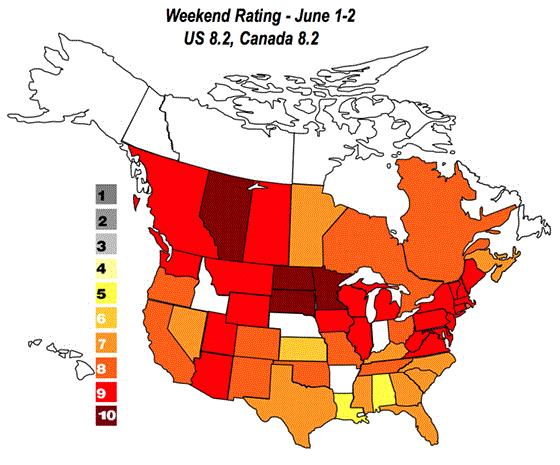
Every region scored 8.5 or above except the West (7.9) and South (6.9). The East led the pack at 9.1, followed by the Northwest and Plains (both 8.8), Midwest (8.7), Mountains and New England (both 8.5). In Chicagoland, we strung together the best two weekend days of the season, plus a fabulous Friday (which I took off to go to the drag races with Dean Bemis) and Monday.
Unfortunately, there were some 3s, 4s and 5s scattered amongst the 8s and 9s. The Mississippi Valley is suffering record flooding and the rain just won’t quit in some spots. Still, customers seem to be getting out to buy. Weekdays have proven to be extra-important this season (and as we learned last year, weekdays average 51% to 58% of the week’s sales for the folks who shared their data with me).
As for Canada, I mentioned above that their 8.2 comes with an asterisk. That’s because, as with the previous weekend, the Yukon and Northwest Territories were unseasonably cold, and sales were off—at least according to my sole reporter for the region, Stan Vander Waal of Rainbow Greenhouses, which ships up there. He reports sales down 64% over the same weekend last year, and down 23% overall, and so scored both territories a 3 (as he did for the previous weekend, too). I opted to leave them out of my spreadsheet, otherwise Canada would have scored 7.6 instead of 8.2. I felt the higher score better reflected the results of the main portion of the country, seeing how BC was an excellent 8.8 and Ontario a strong 8.0.
The Territories may be down, but Stan says the Prairie provinces “have come on-stream with a vengeance.” Alberta and Saskatchewan have made an “awesome recovery,” and Manitoba “just came alive mid-week … and is going gangbusters.” Stan illustrates the change in the region by saying that 10 days ago, their Alberta facility was 160 trailer-loads behind last year. Within about a week they were 40 trailer-loads ahead.

FTD files Chapter 11
Wire service florist FTD filed Chapter 11 bankruptcy protection on June 3 on behalf of all its domestic subsidiaries, which includes the FTD brand, online floral service ProFlowers, Shari’s Berries, and Personal Creations (a personalized gifts website).
According to one news report, the Downers Grove, Illinois-based company has not turned a profit in four years. According to The Wall Street Journal, the filing is due to “an overload of debt it took on to buy former rival ProFlowers in 2014.” However, I also hear that FTD didn’t do a good job integrating the various companies after the purchase.
FTD has arranged $94.5 million in financing to continue day-to-day operations as it tries to sell off its various divisions. It has already entered into an agreement to sell its FTD and ProFlowers businesses in North America and Latin America to Nexus Capital Management for $95 million, pending approval of the Bankruptcy Court and any higher bids; it has letters of intent from two firms to Personal Creations and Shari’s Berries; and it is finalizing the sale of its U.K.-based Interflora to a subsidiary of The Wonderful Company (no doubt Teleflora) for $59.5 million. (In additional to Teleflora, The Wonderful Company also owns Wonderful Pistachios, POM Wonderful and Fiji Water, among other brands.)
FTD has been around since 1910, and their “Mercury Man” logo is one off the best-recognized symbols in the florist world, with 30,000 member florist shops in more than 125 countries, which is why it’s expected FTD will continue under new ownership.

American Community Gardening Association
Maybe it’s because I’ve never gardened in a community garden, but I’d never heard of the ACGA until they put out a call for proposals for their 2019 conference, which is slated for September 12-15 in Indianapolis, Indiana.
Who is the ACGA? Founded in 1982, they’re a non-profit with a mission to “build community by increasing and enhancing community gardening and greening across the United States and Canada.”
Regarding seminar proposals, the organization is looking for topics that illustrate the importance of community gardening. You can be a landscape architect, an arborist, a public park staff member, horticulturist, teacher, food security advocate … most anyone interested in speaking about the topic.
Deadline for submitting proposals is June 15. Click HERE for more info.
Luxury cannabis brand = higher margins
Smoking might carry lots of negative baggage, but there are still those who admire a handsome hand-made tobacco pipe. Which is why it doesn’t surprise me that cannabis company Ionic Brands would want to tap into that aura and mystique by purchasing vintage British pipe purveyor Astley’s of London Limited. They announced the letter of intent on May 30.
Astleys of London was founded in 1862 as a luxury tobacco pipe purveyor on London’s Jermyn Street, a spot well-known for distinctive men’s lifestyle brands. Astley’s was considered to be “the epitome of sophistication and luxury.” Alas, the store closed in the ’90s, but the brand was purchased and relaunched to sell vape pipes and cigars.
Now Ionic Brands has purchased Astley’s with the plan to turn it into a cannabis vape brand, instilling “the glamour, status and elegance of yesteryear,” and deliver it with a “sensitivity and intelligence befitting the modern age.” They are taking aim at the ultra-high-end luxury cannabis market targeting the luxury consumer.
Why should that interest you? It can bring higher margins, says Ionic Brands Chairman and CEO John Gorst.
“While the Astleys of London brand is highly strategic to our overall position in the cannabis industry, we must also consider the deep economic benefits realized by the higher gross margins related to the Astleys luxury brand.”

Plantpeddler expanding
On June 17, Plantpeddler in Cresco, Iowa, will host a groundbreaking celebration of their newest expansion—what they call “Phase 2 Step 2.” Co-owner Mike Gooder told me the “amazing growth” of their young plant business is what’s behind it. In addition, he is helping position the future of the business for his son, John, currently COO, to eventually take over.
The expansion includes about 85,000 sq. ft. of DeCloet open-roof double-poly greenhouse that will be used for on-floor growing of large containers that their grocery customers are demanding. It will include a dedicated four-bay shipping dock for easy in-and-out of finished product.
Equally important is an upgrade to their existing young plant production facilities. They’ve added Logiqs Dutch container benches to four of six zones, with motorized rollerbahn and a high-speed overhead crane in the production barn to avoid bench bottlenecks. Young plants will also have their own dedicated shipping dock, for efficient product flow.
When it comes to other automation, Mike says they’re looking at ISO planters, but haven’t made a decision on them yet, due to the numerous small batches they often need to plant. But they are heavily focused on reducing labor.
The multi-million dollar project will give Plantpeddler more than 550,000 sq. ft. of greenhouse space. They’ll move in by this fall.
Oh, they’re upgrading their trial gardens, too! Make plans to attend their big 40th anniversary open house next August to see everything completed and looking pretty.

Finally …
Some succulents are apparently so hot in parts of Asia that there’s a black market for them being fulfilled by smugglers poaching them on public lands in the U.S. That’s what officials discovered when they tracked three South Korean men who pulled some 3,700 small native succulents called dudleyas, worth $600,000, from various state parks in northern California. One owned a nursery in San Diego county that was being used as a staging area. One of the three was arrested, the other two fled the country.
Click HERE to read the full Washington Post story, which outlines the scale of poaching, which was first discovered in 2017.
Thanks to my old boss John Martens of MasterTag for the link!
See you next time,

Chris Beytes
Editor
GrowerTalks and Green Profit
This e-mail received by 23,686 loyal readers!
Thanks to my loyal sponsors, who help me reach the 23,686 readers of Acres Online in 66 countries. Want to be one of them (a sponsor, that is)? Give Paul Black a shout and he'll hook you up.